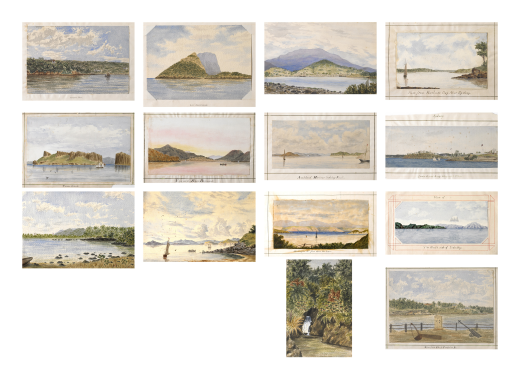ROBERT ACHESON CROMIE MONTAGU 1854-193
ROBERT ACHESON CROMIE MONTAGU 1854-193Estimate $3,000 – $5,000
SYDNEY. GARDEN ISLAND AND LADY (sic) MACQUARIES' CHAIR; VIEW FROM VAUCLUSE, NEARY SYDNEY; KIRRIBILLY POINT; VIEW FROM DOCK. COCKATOO ISLAND; (MT WELLINGTON AND HOBART TOWN FROM KANGAROO POINT); VIEW ON THE RIVER DERWENT; TASMNA (sic) ISLAND; WELLINGTON HARBOUR FROM ABOVE THE TOWN; AUCKLAND HARBOUR LOOKING SOUTH; LORD HOWES (sic) ISLAND; VIEW OF THE SOUTH SIDE OF YEDO (TOKYO) BAY; (WATERFALL, HAWAII(?)); (LAGOON, HAWAII (?)); (COASTAL LANDSCAPE)
watercolour A COLLECTION OF FOURTEEN WATERCOLOURS MADE ON BOARD THE H.M.S. LIVERPOOL (CIRCA 1870) various sizes PROVENANCE These fourteen drawings are from an album of watercolours by Robert Acheson Cromie Montagu (1854-1931). The son of Lord Robert Montagu, a scion of the Dukes of Manchester, young Montagu served as a midshipman on the HMS Liverpool, one of the ships of the Royal Navy ‘Flying Squadron’ which toured the Pacific in 1869-1870 under the command of Rear Admiral Sir Geoffrey Homby. Montagu himself was to enjoy a distinguished naval career, rising to the rank of Lieutenant-Commander before resigning his commission to manage the family estates in county Derry, Ireland. The numerous vessels of the Pacific ‘Flying Squadron’ (the others were the Barsosa, Bristol, Charybdis, Endymion, Liffey, Pearl, Phoebe, Satellite and Scylla) left Plymouth on 19 June 1869, sailing by way of Rio and the Cape of Good Hope to Melbourne, Sydney and Hobart before continuing to New Zealand, Japan and Hawaii then returning to Britain via Chile and Cape Horn. The present works depict many of the places the Liverpool visited en route, with more than half of the drawings of Australian subjects. Although a little naïve, they nevertheless have some historical significance, not only as examples of the (coastal profile) drawing practice which the Royal Navy encouraged in its young officers, but also as records of the appearance of the ports of the Pacific Station around 1870. Dr David Hansen
Robert Acheson Cromie Montagu By descent Private Collection, Melbourne

